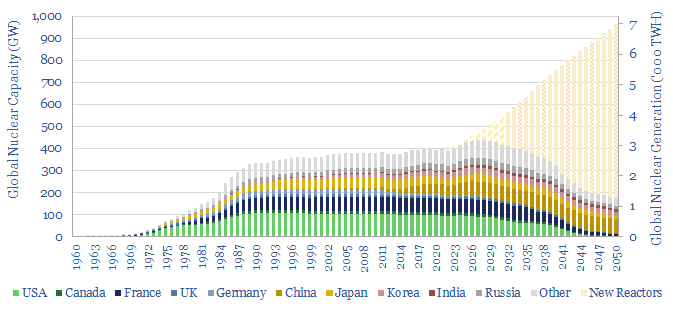How much nuclear capacity would need to be constructed in our roadmap to net zero? This breakdown of global nuclear capacity forecasts that 30 GW of new reactors must be brought online each year through 2050, if the nuclear industry was to ramp up to 7,000 TWH of generation by 2050, which would be 6% of total global energy.
Our outlook for nuclear energy is evolving. Adding 30GW pa of new nuclear capacity per year would be a massive escalation from, as the world has only added around 6 GW per year of new capacity in the past decade.
However, there is precedent, as the world installed 25-30 GW pa of new nuclear reactors at peak, during the mid-1980s, and after a wave of project-sanctioning that followed major energy crises in 1973-74 and 1979-80.
The total base of active, installed nuclear capacity is around 400 GW today, for perspective. Leading countries include the US, with c100 GW of capacity, France with 60GW, China with 50GW and Russia with 30GW. Japan’s nuclear capacity is presently around 45GW, but a large portion of the installed base remains offline post-Fukushima.
Moreover, the average nuclear plant in the world today has been running for 36-years, which means that 10GW of reactor capacity could shut down each year through 2050.
Underlying the analysis is a database of 700 nuclear reactors, including c440 in operation, c200 that have been shut down or decommissioned and around 60 that are in construction. A helpful source in compiling our forecasts is publicly available data from the IAEA, which we have aggregated and cleaned.
The data also show operating lives of nuclear plants, and construction times of nuclear plants, which average 7.5 years from breaking ground through to first power; across different reactor designs and across different countries.
Finally, this breakdown of global nuclear capacity data-file allows you to filter upon individual countries, such as the US, Germany, France of China. Numbers have been updated in October-2024.
